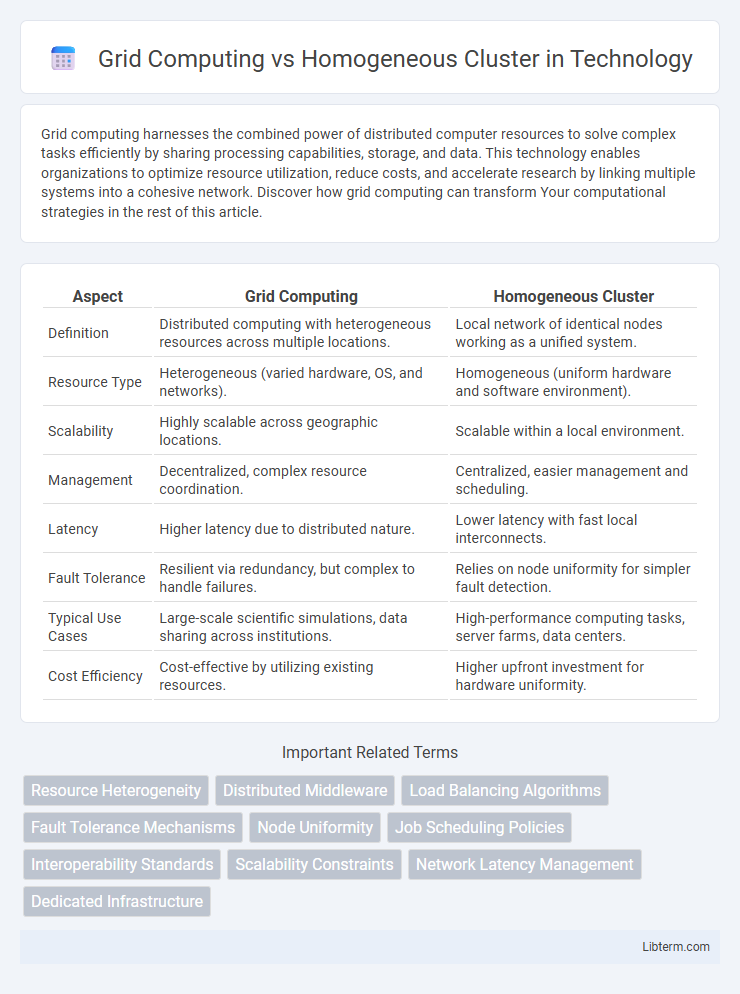Grid computing harnesses the combined power of distributed computer resources to solve complex tasks efficiently by sharing processing capabilities, storage, and data. This technology enables organizations to optimize resource utilization, reduce costs, and accelerate research by linking multiple systems into a cohesive network. Discover how grid computing can transform Your computational strategies in the rest of this article.
Table of Comparison
| Aspect | Grid Computing | Homogeneous Cluster |
|---|---|---|
| Definition | Distributed computing with heterogeneous resources across multiple locations. | Local network of identical nodes working as a unified system. |
| Resource Type | Heterogeneous (varied hardware, OS, and networks). | Homogeneous (uniform hardware and software environment). |
| Scalability | Highly scalable across geographic locations. | Scalable within a local environment. |
| Management | Decentralized, complex resource coordination. | Centralized, easier management and scheduling. |
| Latency | Higher latency due to distributed nature. | Lower latency with fast local interconnects. |
| Fault Tolerance | Resilient via redundancy, but complex to handle failures. | Relies on node uniformity for simpler fault detection. |
| Typical Use Cases | Large-scale scientific simulations, data sharing across institutions. | High-performance computing tasks, server farms, data centers. |
| Cost Efficiency | Cost-effective by utilizing existing resources. | Higher upfront investment for hardware uniformity. |
Introduction to Grid Computing and Homogeneous Clusters
Grid computing integrates numerous geographically dispersed and heterogeneous resources to create a virtual supercomputer capable of handling complex, large-scale tasks by sharing processing power, storage, and data across multiple administrative domains. Homogeneous clusters consist of interconnected computers with identical hardware and software configurations that work together as a single system to enhance performance, reliability, and scalability within a local network. Both paradigms optimize resource utilization but differ in architecture, with grid computing emphasizing resource sharing across boundaries and homogeneous clusters focusing on uniformity and tight coupling.
Core Architecture Differences
Grid computing architecture leverages a distributed network of heterogeneous resources spanning multiple administrative domains, enabling large-scale resource sharing and parallel processing across geographically dispersed systems. Homogeneous clusters consist of tightly-coupled nodes with identical hardware and operating systems, optimized for low-latency communication and high-throughput tasks within a single physical location. The core architectural difference centers on resource heterogeneity and distribution in grid computing versus uniformity and centralized management in homogeneous clusters.
Resource Management and Allocation
Grid computing enables resource management by distributing tasks across heterogeneous, geographically dispersed nodes, optimizing allocation based on availability, workload, and network conditions, which enhances scalability and fault tolerance. In contrast, homogeneous clusters use uniform hardware within a localized environment to streamline resource allocation through centralized schedulers, ensuring predictable performance and low-latency communication. Efficient resource management in grid computing leverages dynamic workloads and diverse resources, while clusters rely on consistency and controlled environments for optimized task scheduling.
Scalability and Flexibility
Grid computing offers superior scalability by integrating heterogeneous resources across multiple administrative domains, enabling dynamic allocation of computing power to handle varying workloads efficiently. In contrast, homogeneous clusters provide limited scalability due to their uniform hardware and centralized management, but they offer predictable performance and simplified maintenance. Flexibility in grid computing is enhanced through support for diverse platforms and applications, whereas homogeneous clusters prioritize consistency and stability over adaptability.
Performance Comparison
Grid computing leverages distributed, heterogeneous resources across multiple locations, often resulting in variable performance due to network latency and resource diversity. Homogeneous clusters maintain uniform hardware within a single data center, delivering consistent high performance through optimized communication and workload balancing. Performance benchmarks typically show homogeneous clusters outperform grids in latency-sensitive tasks, while grids excel in large-scale, loosely coupled computations.
Fault Tolerance and Reliability
Grid computing excels in fault tolerance by distributing tasks across multiple geographically dispersed nodes, ensuring system resilience despite individual node failures. Homogeneous clusters provide high reliability through uniform hardware and tight integration, which simplifies error detection and recovery processes within the local network. While grid computing offers scalability and robustness, homogeneous clusters deliver consistent performance and easier maintenance due to standardized environments.
Security Considerations
Grid computing presents unique security challenges due to its distributed and heterogeneous nature, requiring robust authentication, authorization, and encryption mechanisms across diverse administrative domains. Homogeneous clusters benefit from a unified security policy and centralized management, simplifying vulnerability monitoring and access control within a consistent hardware and software environment. Effective grid security strategies often include the use of Public Key Infrastructure (PKI), secure tunneling protocols like SSL/TLS, and strict adherence to federated identity management systems to mitigate risks of data breaches and unauthorized access.
Use Cases and Application Domains
Grid computing excels in large-scale scientific research, such as climate modeling and bioinformatics, where geographically distributed resources collaborate to process complex datasets. Homogeneous clusters are preferred for high-performance computing tasks like real-time financial modeling and 3D rendering, benefiting from uniform hardware to ensure predictable performance and efficient parallel processing. Application domains leveraging grid computing include global research collaborations and decentralized data analysis, while homogeneous clusters dominate in environments demanding consistent compute nodes, like enterprise simulations and batch processing jobs.
Cost and Maintenance Implications
Grid computing reduces costs by leveraging distributed resources across multiple locations, minimizing the need for centralized hardware investments and lowering infrastructure expenses. Homogeneous clusters require uniform hardware and software, leading to predictable maintenance but higher upfront costs due to specialized equipment and dedicated management. Maintenance in grid computing is more complex because of diverse systems and network dependencies, whereas homogeneous clusters benefit from streamlined updates and easier troubleshooting within controlled environments.
Future Trends in Distributed Computing
Future trends in distributed computing emphasize the integration of grid computing's scalability with the efficiency of homogeneous clusters to enhance resource utilization and workload balancing. Advances in AI-driven orchestration and edge computing are driving dynamic resource allocation, enabling seamless interoperability across heterogeneous environments. These developments aim to create adaptive, resilient infrastructures that optimize performance, reduce latency, and support complex, data-intensive applications at scale.
Grid Computing Infographic

 libterm.com
libterm.com